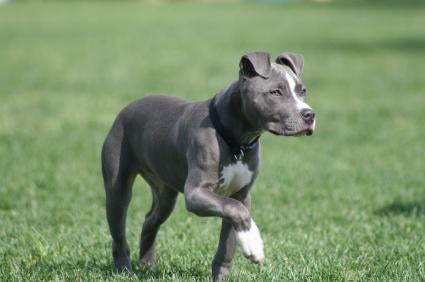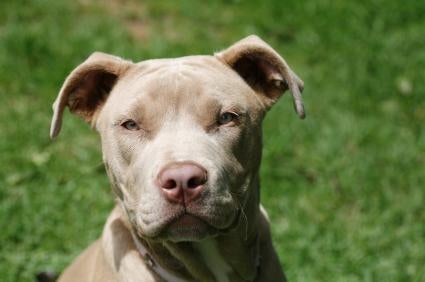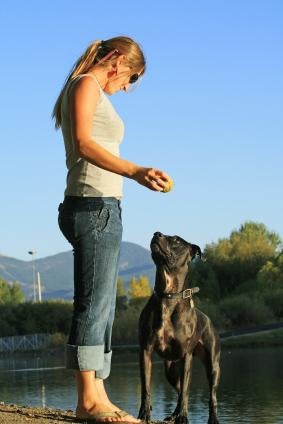Pit Bull Training and Breed Information
Jump straight down to Pit Bull Terrier training information.
Passionate, powerful and fiercely loyal, the Pit Bull Terrier is a versatile, athletic and wonderful companion. With a strong desire to please his/her master, properly trained and socialized Pit Bulls can be extremely affectionate family dogs.
Highly intelligent, they also make excellent protectors and have an uncanny ability to discern a friendly visitor from an intruder. This does not necessarily make them great guard dogs though, as they often prefer to stop for a pet rather than bark if the visitor is a neighbor or friend. You will also find that a properly socialized Pit Bull will be a gentle companion with all family members, including children.

History of the Pit Bull Terrier
The Pit Bull's past shows us how much there really is to admire about this powerful breed. Its ancestors were brought to the United States in the 1800s by Irish immigrants and show the Pit Bulls fairly colorful history. A close relative of the Stafford shire Terrier and other bulldog breeds, the Pit Bull was initially a unanimously popular dog in America.Highly prized for its versatility the Pit Bull was used in World War I artwork, television shows, and even for advertising with a shoe company wanting to illustrate their "sturdy and dependable" shoe. The Pit Bull Terrier was even commonly used as an all-round dependable farm and frontier dog. It wasn't until somewhat later that these dogs were used and bred for fighting.
Appearance of the Pit Bull Terrier
You will find that the typical Pit Bull is built like a Mack Truck or a brick house. With a deep, wide chest and a strong square jaw the Pit Bull is the picture of toughness and power. Set between their strong cheeks, the pit Bull has round eyes that can come in a variety of colors and has short, thick shiny hair that also comes in almost any color. A Pit Bull's ears can be cropped or kept natural and its tail is usually not docked, and tapers to a point. On average, you will find a Pit Bull weighing in at a stocky 35-55 pounds and have a height of 18-22 inches.

Temperament of the Pit Bull Terrier
A correct and well-bred Pit Bull will often be the family goofball - when socialized properly they can develop into a truly remarkable family dog. If you are considering owning a Pit Bull, you will want to purchase from a reputable Pit Bull breeder. Reputable breeders will know the importance of breeding for temperament, which is key in such a powerful dog.With this said, you should also carefully evaluate yourself as an owner before bringing a Pit Bull into your life. Most Pit Bulls have wonderful potential in them, but they are still at times, a willful and strong-minded dog breed. If you are an extremely passive individual with limited knowledge of dog training, you may want to look at some other more suitable breeds. At the same time, if you purchase your Pit Bull as a puppy and are committed to his training, you will very likely end up with a loyal and faithful companion - the dog you'd always hoped for.
A Pit Bull is not typically aggressive towards people but can show aggression towards dogs and other animals. If you commit to proper socialization and training as a puppy, you will eliminate most of these tendencies. Also, if you raise a Pit Bull puppy with other cats and dogs it is not usually aggressive towards these other members of the household. Other small animals outside the household may still be viewed as hunting targets though, but again with proper training and management skills this may never be an issue.
Pit Bulls can bring much entertainment and laughter into the right household. Many family owned Pit Bulls are silly at times and may sprint around your house just looking for some fun. Other times you might find your Pit Bull living the life of luxury on your couch, laying on his back with his legs up in the air and a little drool on the side of his mouth. They do need adequate amounts of exercise and a house with a big yard is preferable for their athletic exuberance. They can however do ok in an apartment with a person who is active and they love to go for bike rides with their owner (jogging beside the bike of course!)
It is only with poor breeding, misuse, improper socialization, and improper training that the Pit Bull can become a problem. This is true for any dog breed though, and is why you must decide that the Pit Bull is the type of dog that fits your knowledge and lifestyle.
Pit Bull Health Problems
Feeding your Pit Bull quality food is absolutely crucial to its health, behavior and lifestyle. Ideally, with Pit Bulls (and other breeds) you will want to choose a high quality premium food for adequate nutrition.Exercise is also important for your Pit Bull. Given that Pit Bulls are an athletic breed, it is important to let them engage in activities that allow them to burn off some steam. A lack of activity can lead to boredom, which usually leads to unwanted behaviors such as chewing, digging, whining and more.....
Generally speaking the Pit Bull is a fairly healthy breed not given to many health concerns. Sometimes hip dysplasia is seen in the breed as well as hereditary cataracts, which again is yet another reason to purchase from a reputable Pit Bull breeder - someone who has the best interests of the breed at heart.
[google_ad:DOTR_CMS_468x60_InArticle2]
Pit Bull Training - This is Important!
As previously mentioned Pit Bulls are a highly intelligent breed who have been bred to work. Therefore they take to obedience training and other dog sports with great enthusiasm and skill. For a Pit Bull, obedience training provides much needed mental stimulation, physical exercise and time spent bonding with you. No wonder they love it so much!
Pit Bulls thrive on non violent, reward based training methods. They are highly motivated students who certainly don't require any harsh corrections or intimidation throughout the training process. Many Pit Bulls have achieved great success with clicker training methods, check out this ebook to help train your Pit Bull - Clicker Training for Pit Bulls.
Along with plenty of puppy socialization your Pit Bull should be taught all the basic obedience training commands such as sit, stay, come, down and go to your spot.
Pit Bulls grow to be big, strong dogs who can be fairly stubborn and will display dominance if allowed to get away with it. They require a firm, consistent and always fair leader to guide them, and set them up for success.
Below are some breed specific issues you are well advised to get right when training your Pit Bull Terrier puppy:
- Pit Bull puppy house training is one of the first and biggest training or management issues to get right. The use of a crate is invaluable in the Pit Bull housebreaking process. As long as pick out and stick to a good house training schedule you'll find that your Pit Bull puppy catches on very quickly. Remember to make it crystal clear to your puppy exactly what you would like him/her to do and always be consistent and fair in the process.
- Pit Bull puppies can be extremely destructive little beasts if they are left alone, full of energy and bored for long periods. You'll find that this pent up energy will manifest itself through digging, chewing, whining and many other destructive behaviors. These problems can be minimized through on leash walks, obedience training and chew toy training.
- A Pit Bull puppy who pulls on the leash is a problem, a fully grown Bully who pulls on his/her leash is a nightmare! This is one behavior that is best taught early and continually reinforced. The last thing you want is for your Pit Bull puppy to develop a leash pulling problem - prevention is better (and easier) than the cure.
- Just as important as leash training is teaching your Pit Bull to stop jumping up on you and your guests. Pit Bulls love to jump up to greet people, but this is obviously an unacceptable behavior for a number of reasons. It's best to teach this to your Pit Bull puppy early in order to prevent this bad habit from taking hold.
The good news is that the "jumping up" behavior is not all that difficult to prevent or put a stop to. The key is to always be clear and consistent with the message that you are communicating to your Pit Bull. In other words you must get it through to your dog that jumping up is never acceptable.
- Another urgent Pit Bull training issue is puppy chewing. Pit Bull's love to chew when they are young and going through the teething stage. Although this is a natural behavior it is also very annoying and can be expensive! There are some simple strategies you can put into place which will help to redirect and minimize the puppy chewing problems.
- Dog to dog aggression is another behavioral problem that Pit Bull owners often report. This comes back to proper socialization and controlling your dog (and the environment) when on or off leash. Puppy kindergarten and Pit Bull obedience training classes are excellent places to provide some much needed interaction with other dogs and people. You can read more about the ins and outs of puppy socialization here - Pit Bull puppy socialization.
As mentioned, puppy kindergarten and some obedience training classes are a good idea for all breeds but especially for Pit Bulls. If you are unable to afford or get to a good class you could study and implement these training methods for your Pit Bull - Secrets of a Professional Dog Trainer.
Pit Bull Breed Overview
The Pit Bull Terrier is a remarkable animal and in the right environment, a loving family dog.If you have decided the Pit Bull is right for you train him, teach him, socialize him, love him and you will have a devoted friend for life.
Please consult the services of a Professional Dog Trainer, Behaviorist or Veterinarian before implementing any of the advice contained on this site.











 Your Privacy Choices
Your Privacy Choices